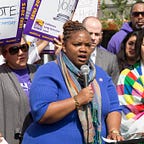Throughout the pandemic, companies and mainstream media have applauded essential workers for their selfless sacrifices and steadfast commitment to their work on the frontline which has provided people with the ability to stay home safely. Despite this widespread support, many of these workers performed their jobs without proper personal protection equipment thus creating higher risk for infection of the virus. The continued fight for adequate PPE, fairer wages, paid sick leave, and transparency on testing, among other things, should serve as a reflection point for our society that we must continue to do more for these unsung heroes on the frontline. And this is especially true for those working in the long term care industry.
The shared personal experiences of these essential workers during the health crisis demonstrates the reality that Covid-19 has a relentless attack on our most vulnerable populations. The concerns of nursing home workers are loud and clear: prioritize our health and safety.
These concerns were reiterated through a recent statewide survey from CHCF and Truth on Call conducted between June 5 and July 12 among 353 employees at California skilled nursing facilities. The findings help us to better understand suspected Covid-19 cases among staff at their facility and provide us with an outlook for the months ahead. Those surveyed included 285 certified nurse assistants, who typically perform the most patient care tasks in nursing homes, as well as other survey participants including people in food service, janitorial staff, housekeeping, and laundry.
The results from the survey revealed that 69% of California nursing home workers outside of Los Angeles reported Covid-19 cases rampant among staff. And in Los Angeles alone, an alarming 89% of residents report known or suspected cases among staff. The pandemic has also continued to exacerbate existing public health inequities among Black and Hispanic communities, with a particularly devastating effect within nursing facilities. Across the state, the percentage of nursing home workers claiming cases rampant among staff rose from 69% to 81% among nursing homes in Black and Hispanic communities. These courageous — and often forgotten — frontline workers of the nursing home industry reaffirm the fight against the virus is far from over.
The survey exposed that 66% of those who work in facilities with half or more Black or Latino residents, report cases among residents. By comparison, 50% of those who work in facilities where less than half of residents are Black or Latino report cases among residents. This is despite the fact that Black and Latino Californians report compliance with prevention measures — like wearing masks, handwashing and social distancing — at above average rates.
The nursing home industry’s workforce, which is made up of predominantly women (81%), immigrants (54%), and people of color (86%), has had disparate effects on both long term care givers and those that they care for, and an urgent calling that their safety and wellbeing is still not being prioritized.
Furthermore, respondents expressed ongoing worries about the availability of tests, protective equipment, and other strategies for combating the virus:
- More than eight in ten respondents say patients and staff are being tested for COVID-19 when needed at least “most of the time.”
- While 77% report adequate personal protective equipment (PPE) at their facility, 23% say PPE is not adequate.
- 88% say their facility has the capacity to quarantine residents who have been exposed to COVID-19 or “cohort” those who have the illness — two key strategies for containing outbreaks.
These findings are a small but important glimpse into the extent of Covid-19’s damaging effects that have ravaged not only nursing home workers, but people of color all across the frontline. Only a mere 38% of California workers are truly confident in their facility’s ability to respond to COVID-19 infections among residents and staff. The lingering insecurity that continues to plague our frontline tells us that there is still work to be done to protect these workers. The members of SEIU Local 2015 have shared their concerns, challenges and fears and we’re taking action for them. Working directly with our members on the ground gives us the unique capability to better understand the immediate measures needed to support all nursing home workers on the frontlines of this pandemic. Some of these measures include:
- Skilled nursing facilities must have a 14-day supply of medical-grade PPE on-hand for staff with ongoing procurement for non-state supply chains;
- Immediate testing of all nursing home workers and patients, and a standardized testing regime statewide going forward;
- Fully-funded, accessible healthcare for every worker, including paid sick leave and 100%-paid testing and treatment for COVID-19;
- Pandemic pay that reflects the essential nature of the work.
We’ve made progress but know the fight to protect workers does not stop. Our work continues in propelling our members forward by taking concrete action to protect them and their loved ones.
